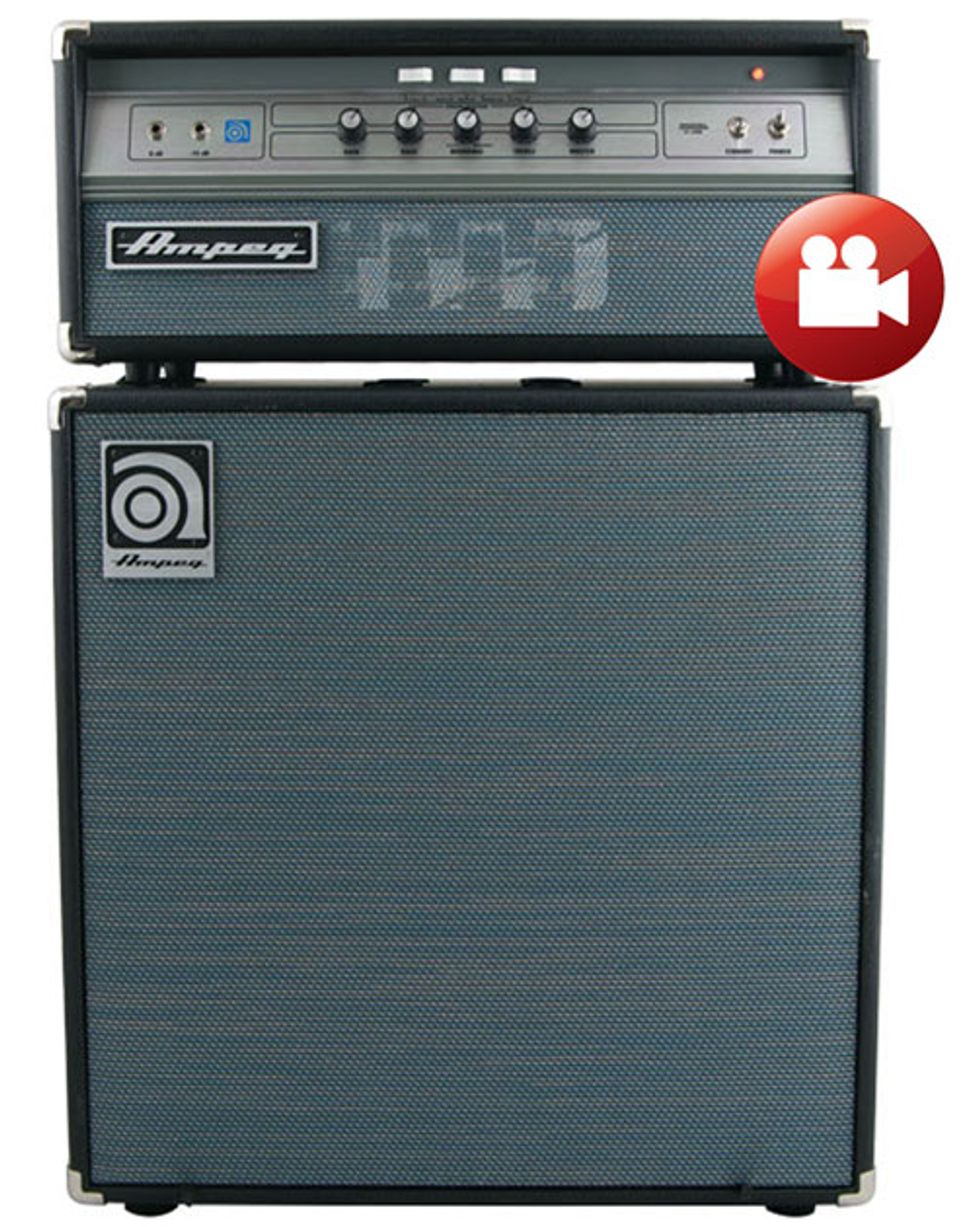If forced to name an industry standard for bass amplification, many players would cite Ampeg. The company’s B-15 is a studio mainstay, and their mighty SVT has jarred fillings loose for decades. Now Ampeg has dipped back into the vault to revive another of their classic bass amps: the V-4B.
The Skinny
The 100-watt V-4B debuted in 1971 as a lower-wattage alternative to the 300-watt SVT. Utilizing the SVT’s preamp, it was a popular (and now collectable) amp, admired for its all-tube tone and straightforward approach.
The new V-4B is an all-tube recreation of the original. There are differences, however, starting with the fact that the new version is 25 pounds lighter. And 40-plus years of R&D have given the Ampeg a chance to modernize in other ways.
Most of these updates reside at the back of the amp. Gone are the original’s 7027A tubes —the reissue hosts a quartet of 6L6s in the power amp, two 12AX7s in the preamp, and a 12AX7 and a 12AU7 for the driver. All eight tubes are housed in a newly designed, rubber-mounted floating chassis designed to isolate the tubes from unwanted vibrations.
There’s also a post-master DI, meaning that the DI signal is congruent with your front-panel master volume setting. There are power amp in/preamp out jacks, plus a slave input for additional power amps. The ground lift has moved to the back, and instead of a single speaker output with selectable impedance, there are five 1/4" speaker outs for 2, 4, or 8 ohm operation. The outs are clearly labeled, taking the guesswork out of adding cabinets—very useful for folks like me that didn’t take Electronics 101.
Ratings
Pros:
Relatively light. Sounds great gritty or clean.
Cons:
A touch pricey.
Tones:
Ease of Use:
Build/Design:
Value:
Street:
$699
Ampeg SVT-212AV
ampeg.com
The front panel boasts a strictly classic look, although it’s not 100% faithful to the original. The two inputs are now at 0 dB and -15 dB (for active basses). Instead of dials for volume 1 and volume 2, the reissue has gain and master-gain controls. The EQ controls and rocker switches are the same as before, but the midrange EQ frequencies are slightly different.
Ampeg has also rolled out a new speaker cabinet that happens to pair nicely with this amp. The SVT-212AV is a 2x12 monster weighing in at a relatively light 66 pounds. This ported enclosure maintains the vintage theme while updating performance. Rated at a foundation-cracking 600 watts at 4 ohms , the Eminence drivers are joined by a 1" compression driver. We generally see 10s and 15s used in bass cabs, but a cab with 12s can bridge between those sounds, offering solid thump with clear articulation.
This amp and cab look great together. If you didn’t know otherwise, you’d probably think you were looking at a 40-year-old setup.
Old Vibe, New Tones
I pulled out a passive mid-’70s Fender P and an active Warwick Streamer Stage I. First I plugged the P into the 0 dB input and set all the amp’s controls (including gain and master volume) to 12 o’clock. Pictures rattled on the wall.
The tone and attitude are thoroughly SVT—that legendary full-bore sound was at my fingertips. The cabinet sounded tight and responsive as I drove the volume higher and higher. The only signal breakup came from the amp, not the cab.
Ratings
Pros:
Can sound like an SVT or a more modern amp.
Cons:
A little pricey.
Tones:
Ease of Use:
Build/Design:
Value:
Street:
$1,299
Ampeg V-4B
ampeg.com
I tried out the active Warwick via the -15 dB input, keeping the EQ flat. I can understand why the designers included this input, but for me, it choked too much of the intended tone, so it was back to the 0 dB input with a master-gain adjustment. The tone was still SVT-like, but because of the Warwick’s midrange nature, I had to roll off some high end.
When I raised the bass EQ control to about 75 percent and engaged the ultra-lo rocker switch, the V-4B produced a nice, clean-bass tone. Slapping and fingerstyle sounded great, the tube warmth nicely complementing my P. The Warwick’s throaty side also emerges at this setting, its active P/J pickups more aggressive than the passive bass. The bevy of modern tones I could dial in when rolling from the neck pickup to the bridge pickup totally surprised me.
Digging deeper, I switched back to the P bass and was able to get a “baby SVT” sound by dialing down the mids and bringing up the bass and treble. The tone was a cross between SVT brashness and a more refined, modern sound.
The Verdict
The original V-4B was more or less a one-tone machine, but this reissue is more versatile. The DI and -15 dB pad are welcome modern additions (though bear in mind that the DI signal won’t sound exactly like a miked cabinet). Meanwhile, the SVT-212AV is the perfect bass-cab complement. Together the components deliver both the classic tones and tighter, more focused modern ones. It’s a welcome evolution, and one that may attract bassists who might not normally look to Ampeg for their sound.
Watch the Review Demo:








![Rig Rundown: AFI [2025]](https://www.premierguitar.com/media-library/youtube.jpg?id=62064741&width=1245&height=700&quality=70&coordinates=0%2C0%2C0%2C0)












 Shop Scott's Rig
Shop Scott's Rig


![Rig Rundown: Russian Circles’ Mike Sullivan [2025]](https://www.premierguitar.com/media-library/youtube.jpg?id=62303631&width=1245&height=700&quality=70&coordinates=0%2C0%2C0%2C0)












































